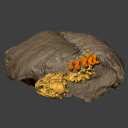















| Plane | Position | Flip |
| Show planes | Show edges |
0.0
M3#967
This the surface model of the steinkern of the shell of Proganochelys quenstedtii.
Data citation:
Ingmar Werneburg , Christina Kyriakouli
and Tomasz Szczygielski
, 2022. M3#967. doi: 10.18563/m3.sf.967
Model solid/transparent

|
A surface scan of the "Tübingen Steinkern", Holotype of Proganochelys quenstedtii (Testudinata), with some historical remarks.Ingmar Werneburg, Christina Kyriakouli and Tomasz SzczygielskiPublished online: 08/08/2022Keywords: Friedrich August Quenstedt; history of science; Holotype; steinkern; surface scan https://doi.org/10.18563/journal.m3.168 Abstract Turtles are one of the most impressive vertebrates. Much of the body is either hidden in a shell or can be drawn into it. Turtles impress with their individual longevity and their often peaceful disposition. Also, with their resilience, they have survived all extinction events since their emergence in the Late Triassic. Today's diversity of shapes is impressive and ranges from the large and high domed Galapagos turtles to the hamster-sized flat pancake turtles. The holotype of one of the oldest fossil turtles, Proganochelys quenstedtii, is housed in the paleontological collection in Tübingen/Germany. Since its discovery some years before 1873, P. quenstedtii has represented the 'prototype' of the turtle and has had an eventful scientific history. It was found in Neuenhaus (Häfner-Neuhausen in Schönbuch forest), Baden-Württemberg, Germany, and stems from Löwenstein-Formation (Weißer Keupersandstein), Late Triassic. The current catalogue number is GPIT-PV-30000. The specimen is listed in the historical inventory “Tübinger Petrefaktenverzeichnis 1841 bis 1896, [folio 326v.]“, as “[catalogue number: PV]16549, Schildkröte Weiser Keupersandstein Hafnerhausen” [turtle from White Keuper Sandstone]. Another, more recent synonym is “GPIT/RE/9396”. The same specimen was presented as uncatalogued by Gaffney (1990). Here we provide a surface scan of the steinkern for easier access of this famous specimen to the scientific community. M3 article infos Published in Volume 08, issue 03 (2022) |
|